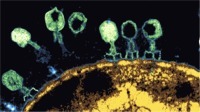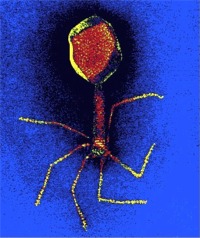

Smithsonian Magazine
The Return of the Phage As deadly bacteria increasingly resist antibiotics, researchers try to improve a World War I era weapon.
Amid the din from street musicians, panhandlers and baby-toting moms along Baltimore's Inner Harbor, a petite woman wearing surgical gloves squats down on an embankment wall. She dips a sterile white bucket into the water, pulls it up, then peels off her gloves, and in seconds vanishes.
Few onlookers would guess Ekaterine Chighladze is a mercenary in a microscopic war. She marches the unsavory water past Camden Yards, the Baltimore Orioles' playground, and ducks into a lab of the University of Maryland.
She repeats this process every two weeks. So even before her analysis, she knows the bucket is chock-full of naturally occurring predatory viruses called bacteriophages " phages for short. After more than a half century of neglect in the West, these tiny viruses are gaining new consideration as slayers of so-called superbugs " those often deadly bacteria ever more resistant to conventional drug treatment.
"Modern medicine could be set back to its pre-antibiotic days," Alexander Sulakvelidze, who runs the lab, says from behind a lab bench piled high with agar dishes of bacteria. In 1998 the professor of medicine cofounded a Baltimore company called Intralytix to manufacture phages. "All the advances that we take such pride in, from transplants to chemotherapy," he says, "may become impossible when bacteria develop resistance to antibiotics."
According to a recent World Health Organization (WHO) report, nearly all gonorrhea strains are unchecked by penicillin in Southeast Asia. In India, typhoid species have developed resistance to three drugs commonly used against them. Drug-resistant tuberculosis has invaded one in ten TB patients in Estonia, Latvia, and parts of Russia and China. In Thailand, the top three antimalarial drugs have been rendered useless.
"The phenomenon isn't just happening in developing nations," says Richard Honour, president and CEO of Phage Therapeutics International, a fledgling company in Bothell, Washington. "More American lives are lost each year to antibiotic-resistant bacterial infections than were claimed by the entire Vietnam War," he says. The WHO reports that some 14,000 people die each year just from drug-resistant infections picked up in U.S. hospitals. Worldwide, up to 60 percent of hospital-acquired infections turn out to be drug-resistant.
Phages are among the simplest organisms on the planet. About a millionth of an inch in size, a fraction of most bacteria, phages become visible only under an electron microscope. A milliliter of water can contain up to a trillion. They thrive anywhere bacteria can exist " in raw sewage, open water, humans and practically everywhere else, says Carl Merril, chief of the biochemical genetics lab at the National Institute of Mental Health (NIMH). Some phages reproduce by invading a bacterium and forcing it to manufacture copies of the phage until the host is overwhelmed, he explains. Eventually, the progeny either dissolve or burst the cell wall, destroying the host bacterium, and move on, ready to prey on surrounding bacteria. A single phage can produce tens of thousands of offspring in an hour, growing exponentially from there. Other phages reproduce by becoming a part of the bacterium's genome. When the bacterium reproduces, so does the phage.
Human phage therapy is hardly new. Before the discovery of penicillin, pioneering doctors around the world employed phages as healers, giving them by potion or injection. These stalkers of bacteria were discovered during World War I by British bacteriologist Frederick Twort and independently two years later by the French-Canadian Felix D'Herelle, a self-taught medical maverick then at the Pasteur Institute in Paris. Both observed mysterious activity that produced clear areas in agar plates otherwise cloudy with thriving bacteria. Something was killing the bacteria. D'Herelle identified the microscopic marvel as a new type of parasite. "In a flash I had understood what caused my clear spots was in fact an invisible microbe...a virus parasitic on bacteria," he wrote. He named it bacteriophage, derived from two Greek words and meaning "bacteria devouring."
Early on, phages held much promise in conquering many of the world's scourges. D'Herelle went on to set up an institute with microbiologist George Eliava in Tbilisi, the capital of Georgia. There, they harvested phages from the nearby Kura River for culturing. Though D'Herelle left during the Stalinist era and Eliava was executed, the Eliava Institute of Bacteriophage, Microbiology, and Virology flourished. In the late 1930s, it churned out phages by the ton. Patients threw back their heads and swallowed a solution of the phages. Several major U.S. pharmaceutical companies " Eli Lilly, for one " entered the field.
But the advent of sulfa drugs and antibiotics in the 1940s relegated phages to the backseat " at least in Western countries. While phages frequently and inexplicably failed, antibiotics, it seemed, were fail-safe. Physicians preferred the new class of drugs because they were relatively easy to use, killed a broad spectrum of bacterial infections and didn't pose the risk living organisms do.
Later on, because of their structural and genetic simplicity and ease of growth in the lab, Western researchers tapped bacteriophages as model systems to study the molecular basis of genetics, spawning the science of molecular biology. The lab techniques that made the revolution possible were largely advanced through research on phages and their bacterial hosts.
"If you look at the early Nobel Prizes in molecular biology, half of the awards went to researchers using phages," NIMH's Merril says. The work also helped researchers understand the shortcomings of phage therapy of the past. Some of the preparations were contaminated. On top of that, early researchers didn't realize that each phage type is highly specific for a given bacteria species, more finicky than Morris the cat.
Back in the Baltimore lab, Chighladze painstakingly isolates phages from harbor water by culturing them with sundry strains of bacteria. Modern technology can decipher which type of phage kills which type of bacteria. For a broad spectrum assault, purified phages can then be combined in cocktails.
Over time, bacteria naturally develop resistance to phages, as they do to antibiotic drugs. Drug resistance, however, has been accelerated by global misuse of antibiotics. Phages, in contrast, can adapt to keep up with the bacteria, matching their prey mutation for mutation. "It's a biological arms race," explains Sulakvelidze, a former Georgian lab director who worked extensively with the Eliava Institute. Back in Tbilisi, phages never fell out of fashion. They've been in use in humans for 70 years with claims of miraculous results. Phages offer other advantages over antibiotics. For starters, they don't harm benevolent bacteria living in symbiosis with human hosts. But even with such positive traits, phages do have their downside.
Rather than kill bacteria, some phages make them even more lethal. This happens, for example, with the bacterium that causes cholera.
In the mid-1980s interest in the West was renewed when British and Polish researchers studied phage success against microbes in animals. But burgeoning cases of antibiotic-resistant bacterial infections really prompted the surge in Western research.
Today Intralytix and Phage Therapeutics, like a handful of other companies, are developing phage catalogs to sequence the genetic code of a select hundred or so of the inestimably large number of species of bacteria-killing viruses found in nature. Although Intralytix has opted to use only naturally occurring species for now, other companies are attempting to genetically engineer phages so that they overcome bacterial resistance.
The first human clinical trials in the United States are slated to begin within a year. Possible applications include impregnating artificial skin or other materials with phages to heal infected wounds, intravenously medicating patients suffering from bacterial infections of the bloodstream, and culturing custom phage therapies from infected patients.
Psychological barriers to phage acceptance remain. "Some people worry about getting treated with a virus," Merril says, "but they don't realize that many of today's leading vaccines are made with live virus." Yet even Merril doubts phages will ever be a panacea or more than an adjunct to antibiotics.
Whatever the future, phages have already earned a respected place in the annals of medicine. We shall see how much larger their entry becomes.
By Julie Wakefield
Cover Image - October 2000









